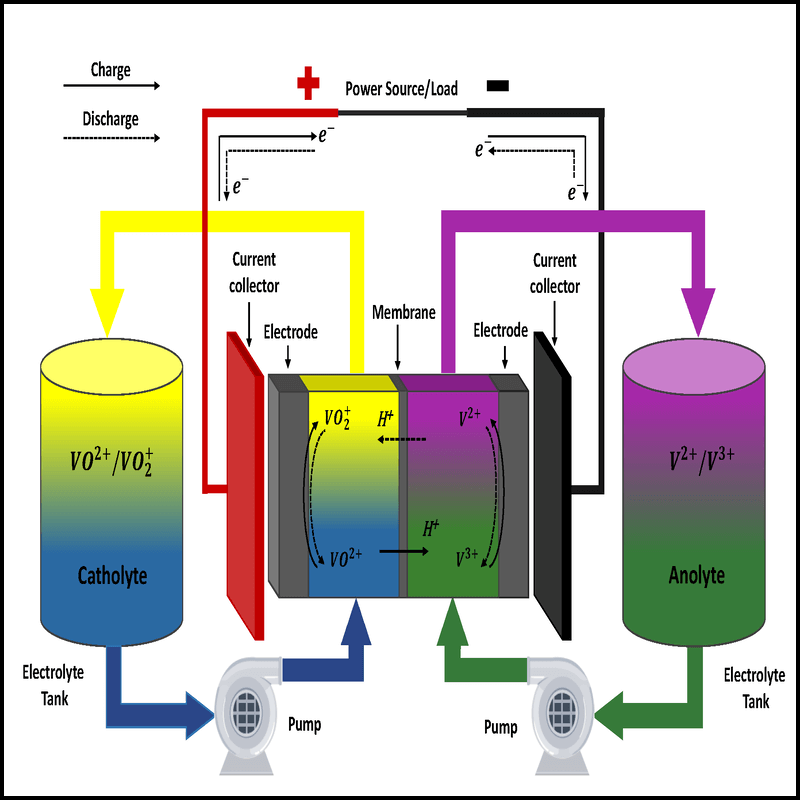
India has inaugurated its largest and first megawatt-hour (MWh)-scale Vanadium Redox Flow Battery (VRFB) system, boasting a 3 MWh capacity. Read here to learn more about the breakthrough in India’s energy storage mission.
India recently achieved a major milestone in its clean energy transition with the inauguration of the country’s first megawatt-hour (MWh)-scale Vanadium Redox Flow Battery (VRFB) system, with a 3 MWh capacity.
This development marks a significant step toward establishing long-duration energy storage (LDES) solutions, which are essential for integrating renewable energy into the national grid.
What is a Vanadium Redox Flow Battery (VRFB)?

A Vanadium Redox Flow Battery is an electrochemical energy storage system that uses vanadium ions in multiple oxidation states (V²⁺, V³⁺, V⁴⁺, V⁵⁺) to store and release energy through redox reactions.
- Each electrolyte tank contains vanadium ions in distinct oxidation states, typically V²⁺/V³⁺ in one tank and V⁴⁺/V⁵⁺ in the other.
- During charging, electrical energy from renewable sources like solar or wind drives the ions to higher oxidation states, effectively storing the energy chemically.
- When discharging, the reverse reaction releases the stored energy as electricity.
- This design makes VRFBs highly modular. Energy capacity depends on the volume of the electrolyte tanks, while power output is determined by the size of the electrochemical cell stack.
- The two can be scaled independently, a flexibility that lithium-ion systems lack.
- Unlike lithium-ion or solid-state batteries, where energy is stored in solid electrodes, a VRFB stores energy in liquid electrolytes housed in external tanks.
- The energy capacity depends on the volume of electrolyte, while power output is determined by the cell stack size, enabling independent scaling of energy and power.
Advantages of VRFB Technology
- Long Lifespan and Deep Discharge Capability: Can operate for over 20 years with >10,000 charge-discharge cycles.
- High Safety and Stability: Uses non-flammable, aqueous vanadium electrolytes, ensuring operational safety.
- Scalability and Modularity: Energy storage capacity can be increased simply by enlarging electrolyte tanks.
- High Efficiency and Fast Response: Offers 70-80% round-trip efficiency and instant response suitable for grid balancing.
- Deep Discharge Capability: VRFBs can be fully discharged (100%) without damage, unlike lithium-ion systems that require partial discharge limits to preserve battery health.
- Sustainability: Vanadium electrolytes are fully recyclable, reducing environmental impact and lifecycle costs.
Significance for Renewable Energy Integration
India’s renewable energy generation, particularly solar and wind, is inherently intermittent, depending on weather and time of day.
This intermittency poses challenges to grid reliability and energy dispatch.
VRFBs provide the following advantages in this context:
- Store excess renewable power during peak generation hours.
- Release stored energy during low generation or peak demand periods.
- Stabilise the grid by balancing frequency and voltage fluctuations.
- Enable 24×7 renewable power supply, essential for achieving India’s 500 GW non-fossil fuel capacity target by 2030.
Strategic and Economic Importance
- Energy Security and Atmanirbhar Bharat: VRFBs can reduce dependence on imported lithium, as India imports almost all its lithium-ion cells. Vanadium, though not widely mined domestically, can be sourced through urban mining and industrial by-product recovery, strengthening self-reliance.
- Support for Green Hydrogen and Electric Mobility: Stable long-duration storage supports round-the-clock renewable electricity, a prerequisite for green hydrogen production and EV charging infrastructure.
- Grid Resilience: VRFB systems can provide backup power, black start capability, and frequency regulation, enhancing overall grid stability.
Challenges
- High Initial Cost: Although lifecycle costs are competitive, upfront capital investment remains high.
- Limited Domestic Vanadium Supply: India needs to develop vanadium extraction and recycling infrastructure.
- Limited Awareness and Market Acceptance: Flow batteries are relatively new in India’s energy sector, necessitating capacity building and technical training.
- Policy Push Required: Inclusion of flow batteries in energy storage tenders, fiscal incentives, and R&D support under the National Energy Storage Mission (NESM) can accelerate deployment.
Conclusion
The commissioning of India’s first 3 MWh Vanadium Redox Flow Battery marks a decisive move toward sustainable, indigenous, and scalable energy storage.
As India accelerates toward a carbon-neutral future by 2070, technologies like VRFBs will be instrumental in bridging the gap between renewable generation and reliable supply, reinforcing energy independence and grid resilience.
Related articles:







Leave a Reply